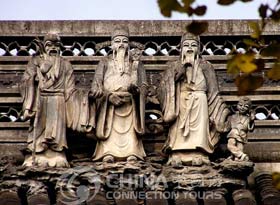
 Lion Grove Garden (Shizilin) is located at 23 Yuanlin Road, in the northeast of Suzhou. It is one of the four most famous and representative classic gardens in Suzhou (the other three being the Surging Wave Pavilion, Lingering Garden and Humble Administrator's Garden). It is built in 1342 during the Yuan Dynasty (1279-1368) by Monk Tianru and a group of Buddhists of the Zen Sect, in the memory of High Monk Zhongfeng.
Lion Grove Garden (Shizilin) is located at 23 Yuanlin Road, in the northeast of Suzhou. It is one of the four most famous and representative classic gardens in Suzhou (the other three being the Surging Wave Pavilion, Lingering Garden and Humble Administrator's Garden). It is built in 1342 during the Yuan Dynasty (1279-1368) by Monk Tianru and a group of Buddhists of the Zen Sect, in the memory of High Monk Zhongfeng.
Covering an area of about 1.1 hectares, Lion Grove Garden is an ideal site for sightseeing as it has richly ornamental pavilions and towers in different styles, each having its own history and story. Zhenquting (True Delight Pavilion) is the most magnificent in Lion Grove Garden. Built in royal architectural style, it has a horizontal board inscribed by Emperor Qianlong of the Qing Dynasty, who visited the gardens six times. Lixuetang (Standing-in-Snow Hall) was named according to a Buddhist story which tells how a devoted Zen adherent stood in snow for a whole night to worship his master monk. Wenmeige (Pavilion for Greeting the Plum Blossoms) was a place where painters and poets gathered. In addition to the plum trees around the pavilion, all the furniture and utensils inside are all decorated or carved with designs of beautiful plum blossoms. Furthermore, many rare tablets and steles, paintings and calligraphy works are kept in Lion Grove Garden. Among them are precious Ming-dynasty artworks such as "Panoramic View by Ni Yunlin and the "Twelve Scenic Spots in Lion Grove Garden" by Xu Ben. A representative garden of the Yuan Dynasty, the most noted attraction of the Lion Grove Garden is the labyrinthine rockery made of limestone from the Taihu Lake. Rocks in this "Kingdom of Rockery" are piled up skillfully and ingeniously, and most of them look like lions in different postures and verves: playing, roaring, fighting, sleeping, or even dancing. It is said that in the past, looking north from Xiaofangting (Small Square Hall), one could see nine stone lions standing in a row and that is the Nine-Lion Peak. Due to the changes and ravages of the time and the erosion of elements, the peak now only bears little resemblance to lions.

